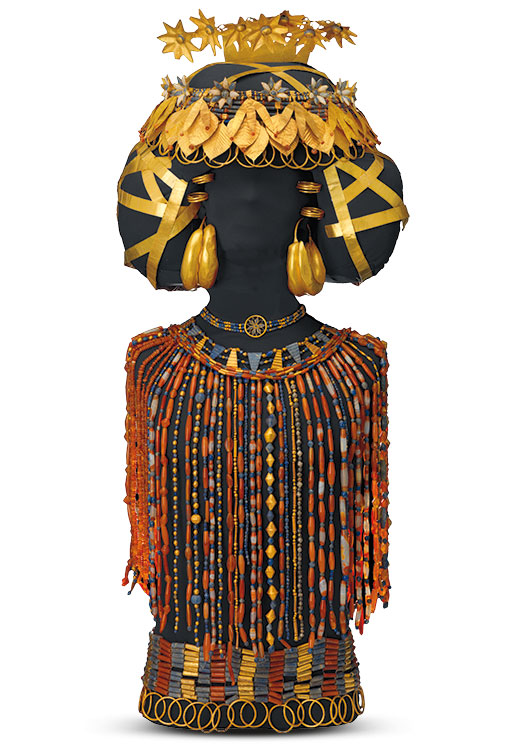
Puabi’s funerary ensemble is a feast for the eyes with its vibrant colors, precious materials, and skilled artisanship. Several wreaths formed of floral and vegetal motifs once rested on her forehead. Ribbons of thinly hammered gold would have circled her voluminous hair. At the crown of her head sat a large gold comb, featuring seven delicately curving flowers. Large lunate earrings dangled from her ears, and gold coils from her hair. These radiant accessories would have formed a halo around Puabi’s face. Below, a choker with a central rosette sat against her neck. A profusion of carnelian, lapis lazuli, and gold beads covered her chest, strung in rhythmic patterns. Finally, a belt of beads with a fringe of disks would have rested against Puabi’s hips.
Queen Puabi’s funerary ensemble
Mesopotamia, Sumerian, Ur (modern Tell el-Muqayyar), PG 800, Puabi’s Tomb Chamber, on Puabi’s body
Early Dynastic IIIa period, ca. 2500 BC
Gold, lapis lazuli, carnelian, silver, and agate
University of Pennsylvania Museum of Archaeology and Anthropology, Philadelphia, USA, Excavated 1927/28
Courtesy of the Penn Museum
Sidney Babcock: Queen Puabi's funeral in the city of Ur was a meticulously planned event. Her body was dressed in full regalia; her tomb was filled with objects displaying her status and wealth. All carved of exquisite lapis lazuli imported from modern-day Afghanistan, three cylinder seals were carefully attached to three garment pins that secured her cloak. This particular seal was found together with the garment pin that is also on view in this case.
Here, Puabi is shown seated in the upper register, participating in a banquet. The artist paid special attention to her representation: her dress, hair, and face are clearly defined, and her chair is more decorative than those of the other celebrants, all of whom are men. One of her two female attendants gently rests her hand on Puabi’s back, an easily missed detail suggesting the close relationship between an elite woman and her female entourage.
This seal is among the very few banquet scenes from Ur which contained inscriptions. In contrast to the practice of the time where women were described in relation to their male kin, Puabi's inscription only gives her name and title as queen, suggesting that she ruled in her own right.
